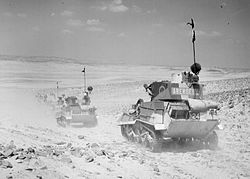Light tanks of the United Kingdom
| Tank, Light, Mk I to Mark V | |
|---|---|

Vickers light tanks cross the desert, 1940
|
|
| Type | Light tank |
| Place of origin | United Kingdom |
| Production history | |
| Designer | Vickers-Armstrongs |
| Manufacturer | Vickers-Armstrongs |
| Unit cost | £7,700 (1927, excluding the gun) |
| Variants | Mk I, Mk II, Mk III, Mk IV, Mk V |
| Specifications (Light Tank, Mark V) | |
| Weight | 4.75 long tons (4.83 t) |
| Length | 12 ft 10 in (3.91 m) |
| Width | 6 ft 9 in (2.06 m) |
| Height | 7 ft 3 in (2.26 m) |
| Crew | 3 (commander, gunner, driver) |
|
|
|
| Armour | 12 mm maximum |
|
Main
armament |
.50 in Vickers machine gun |
|
Secondary
armament |
.303 in Vickers machine gun |
| Engine |
Meadows 6-cylinder petrol 88 hp |
| Suspension | Horstmann inclined springs |
|
Operational
range |
130 mi (210 km) |
| Speed | 32.5 mph (52.3 km/h) |
The Light Tank Mark I to Mark V were a series of related designs of light tank produced by Vickers for the British Army during the interwar period.
Between the First and Second World Wars, the British produced a series of similar light tanks. They saw use in training, and in limited engagements with British Empire units such as the South African Army during the East African Campaign of 1941. All were around 5 long tons (5.1 t) in weight and capable of 30 mph (48 km/h) on roads and around 20 mph (32 km/h) cross-country.
The British did not expect their light tanks to be used against anything except other light tanks at most and as such armament was a machine gun only—Vickers machine guns firing either a .303 inch or .50 inch (12.7 mm) round. Suspension was Horstmann coil spring on bogies. The engine was a Meadows 6-cylinder petrol. Up until the Mk V, they were crewed by a driver/commander and gunner. The Mk V had a driver, a gunner and the commander helping on the gun.
The various marks were produced in relatively small numbers. By the Mark V, the design was more or less optimized and it was the final development of in the form of the Light Tank Mk VI which was chosen for the British Army expansion programme in expectation of war.
The following designations in the sequence Light Tank Mk VII "Tetrarch" and Light Tank Mk VIII "Harry Hopkins" were produced by Vickers but unrelated to the series of Light Tanks Mk I to Mark VI.
Following the activities of the Experimental Mechanized Force in the late 1920s, the British Army identified a need for two light tracked vehicles; one to carry a machine gun for the infantry and one with a turret for the Royal Tank Corps. The Carden-Loyd tankette became the infantry vehicle, at the same time Carden developed privately a number of light two-man tank designs. Carden's Mark VII design was accepted as a prototype for the Army's light tank. By that point Carden-Loyd was part of Vickers-Armstrong. Only a few of the first light tanks were built and although never issued per se gave useful information for subsequent development.
...
Wikipedia
